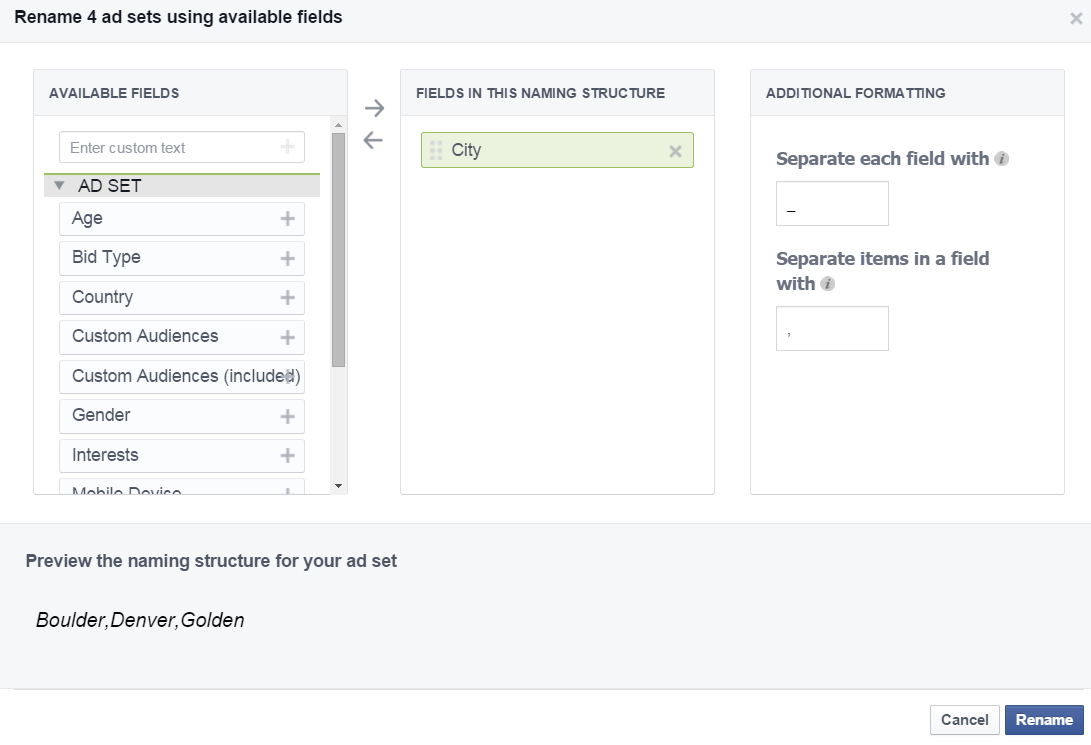What Should You Name Your Facebook Ad Sets?

Whether you are a seasoned Facebook marketer or just beginning to learn the ropes, naming your ad sets can sometimes be an art form. While it may not seem all that important, once you start getting upwards of 20-30+ audiences in your campaign, sorting things out can get more than a little jumbled and confusing.

regardless of what’s happening.
So how should you name your ad sets you ask? While it really does ultimately depend on your preference to make it easier on your brain, here are some suggestions that may put you on the right path and ignite your organizational spirit!
Take Advantage of Facebook’s New “Naming” Feature
It’s about time! If you are in a time crunch or don’t want to come up with custom naming conventions for all of your ad sets, Facebook now has a feature that will name (or rename) all of your ad sets for you. It is also very simple to use (surprised? Me too). While editing a single or group of ad sets, just click the edit pencil icon and select the “Rename using available fields” link.

This brings up a pop-up window in which you can select the fields you would like to include in your new ad set name (you can re-arrange them as you please). You can edit the way the categories are separated (such as a comma, plus sign, dash, etc.) and click “Rename” and BAM! Suddenly your ad sets all follow the same naming structure! The best part is, Facebook will save this naming “formula” you have created so that you can continue to apply it to the campaign, eliminating the need to go through this process for every audience.

The only issue is the available fields are limited, so if you want to get more specific and fancy you will have to take matters into your own hands.
Which leads me to …
Taking Matters into Your Own Hands – Creating Your Own Custom Naming Structures
Creating your own formula for naming your ad sets can be very beneficial when scanning through them. Here at Clicks and Clients, we have found being as specific as possible is the best way to go – as well as being consistent. For example, if you have an ad set targeting Women between the ages of 25-35 who live in Denver and have an Interest in yoga, you could name your ad set “Denver + Women + 25-35 + Yoga” (or whatever order you feel fits best with your campaign). Moreover, for more specificity, you could add the categories before; i.e. “Location/Demo/Interest – Denver + Women + 25-35 + Yoga.” The possibilities are seemingly endless.

The good news is, you can come up with a structure that works best with what you are doing. A good rule of thumb to follow is to list out the specifics and keep the field that is changed most (such as Interest) at the end of the formula (keeping the most commonly used targeting method in the beginning) so you can quickly glance at the ad sets (or order them alphabetically) and more easily see the differences between targeting. This method works great when using Lookalike Audiences by being able to easily view the percent size range if you are using multiple!
Other Quick Tips
- Put the date the ad set was created at the end of the naming formula.
- Add “Test” to the beginning of new audiences you are testing.
- Take advantage of ordering ad sets alphabetically.
- Avoid too many abbreviations within the naming structure.
So toss out the old “Audience 1,” “Audience 2” and “Audience 3” naming scheme and get into the habit of creating a structured formula – not only for your sanity’s sake, but to save time too!

Tags In
Recent Posts
Recent Comments
- Shannon Thammasiene on How to Create a Successful Blog
- Sarah on How to Create a Successful Blog
- How to Create a Successful Blog on 5 Free Keyword Research Tools that will Rock your Socks
- Olivier Hamphrey on This Week In Social Media
- Richard Dickerson on Use Email to Sell without Selling



